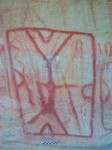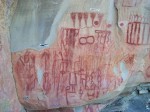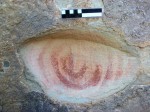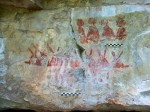 Archaeologists have discovered 4,926 paintings left by pre-Hispanic hunter-gatherers on the walls of caves in Burgos in the San Carlos mountain range of Tamaulipas, in northeastern Mexico. There are three stages of paintings left by three different groups of nomadic hunter-gatherers at different periods in 11 caves. Their existence upturns a long-standing historical assumption that there were no pre-Hispanic peoples in Burgos. We now know there was at least one indigenous nomadic group travelling through the area before the Conquista.
Archaeologists have discovered 4,926 paintings left by pre-Hispanic hunter-gatherers on the walls of caves in Burgos in the San Carlos mountain range of Tamaulipas, in northeastern Mexico. There are three stages of paintings left by three different groups of nomadic hunter-gatherers at different periods in 11 caves. Their existence upturns a long-standing historical assumption that there were no pre-Hispanic peoples in Burgos. We now know there was at least one indigenous nomadic group travelling through the area before the Conquista.
One of the caves, the Horse Cave, had a particular abundance with more than 1,550 paintings recorded. The images in the caves show anthropomorphic figures engaged in activities like hunting, fishing and gathering, zoomorphic figures like deer, lizards and centipedes, local plants and flowers, astronomical imagery, conical tent housing much like tipis and abstract designs.
 It hasn’t been possible to date them yet because no pottery or other datable remains were found to associate with the paintings that could establish a timeline. It might be possible to date the paint directly by scraping some samples and radiocarbon dating. The paints used — red, yellow, white and black — were all derived from organic dyes and minerals. Chemical analysis would identify exactly what materials they were made from, but again, that would require intrusive sampling so they’re not rushing into it.
It hasn’t been possible to date them yet because no pottery or other datable remains were found to associate with the paintings that could establish a timeline. It might be possible to date the paint directly by scraping some samples and radiocarbon dating. The paints used — red, yellow, white and black — were all derived from organic dyes and minerals. Chemical analysis would identify exactly what materials they were made from, but again, that would require intrusive sampling so they’re not rushing into it.
Martha García Sánchez, of the Autonomous University of Zacatecas worked with the National Institute of Anthropology and History (INAH), to document the cave paintings. She first learned there was rock art in Burgos in 2006 but was only able to start investigating and recording the paintings in 2011 ago thanks to the support of the National Fund for Culture and the Arts. In two years they’ve covered an exceptional amount of ground, but there are many more than 11 caves in the area.
 Trying to pin down who made these works of art is going to be a challenge. Martha García Sánchez, when she announced the finds at the second meeting of Historic Archaeology in Mexico’s National History Museum, said that she had assiduously researched colonial records, news and reports at the National Archives and multiple regional archives but there was nothing in the historical record referring to nomadic groups in Burgos or Tamaulipas predating the arrival of Spain. The only people mentioned are Spanish, Creole and French post-Hispanic settlers.
Trying to pin down who made these works of art is going to be a challenge. Martha García Sánchez, when she announced the finds at the second meeting of Historic Archaeology in Mexico’s National History Museum, said that she had assiduously researched colonial records, news and reports at the National Archives and multiple regional archives but there was nothing in the historical record referring to nomadic groups in Burgos or Tamaulipas predating the arrival of Spain. The only people mentioned are Spanish, Creole and French post-Hispanic settlers.
There are references to indigenous groups who fled the conquering Spaniards and hid out in the San Carlos mountains for 200 years. As late as 1750 there are records of these nomadic peoples making it hard to evangelize Burgos. There are no official names of the tribes. They are referred to by nicknames assigned them based on perceived characteristics like “painted” or “mangy,” clothing or activities like “shoemakers,” or the family names of ranchers by the random assortment of conquistadors, religious men and indigenous peoples who ran into them.
 There wasn’t much in the way of congress, therefore. The Spanish avoided following them into the mountains, and since there was a literal bounty on their heads — 25 pesos for every indigenous scalp and 60 pesos for every ransomed “captive” — these groups were destroyed before anything about them was recorded. We know basically nothing about their languages, religious rituals and cultural traditions. This huge cache of art, therefore, is an immensely important anthropological resource.
There wasn’t much in the way of congress, therefore. The Spanish avoided following them into the mountains, and since there was a literal bounty on their heads — 25 pesos for every indigenous scalp and 60 pesos for every ransomed “captive” — these groups were destroyed before anything about them was recorded. We know basically nothing about their languages, religious rituals and cultural traditions. This huge cache of art, therefore, is an immensely important anthropological resource.
wow!!! what an awesome discovery. I would love to know more. Thanks for all your hard work. wish I could be there!
I just love hearing about these cave paintings thanks for such great pictures.
They may have been Coahuiltecan cultures. There is a book titled “Hokan-Coahuiltecan Studies” by Margaret Langdon. One Coahuiltecan language differed from another Coahuiltecan language. These languages have been placed in this one group by linguists. The Coahuiltecans were hunters and gatherers of plants, roots, nuts, and berries. These people also created pottery. They wore scant clothing. Their habitat was Tamaulipas, Nuevo Leon, Coahuila, and South Texas. The Coahuiltecan languages are no longer spoken.